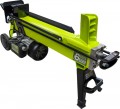Splitting force
The greatest force that the wood splitter is able to apply to the workpiece in the process of splitting.
This parameter is relevant for hydraulic and rack units (see "Type"). Even in the simplest such devices, the splitting force reaches several tons. In general, high force allows you to cope with hard and thick workpieces, however, it requires high power and strength, which significantly affects the price and weight of the entire unit. Therefore, it is worth choosing a model according to this characteristic, taking into account the specifics of the work.
So, for use in the private sector, a wood splitter with a splitting force of up
to 5 tons is considered quite sufficient, for boiler rooms and other relatively large consumers —
5-8 tons (up to 10 tons), and
more powerful devices are intended mainly for industrial use.
Max. power
Wood splitter motor power in watts. The designation in watts is used for all types of engines, which allows you to compare units with different types of motors.
A powerful motor is needed above all in order to provide a high splitting force (see above). However, when choosing, it is worth focus not so much on power, but on the force stated in the characteristics and the length / thickness of the logs. In addition, in the case of electric motors (see "Motor type"), the power directly determines the energy consumption, which is important in some situations (when running from a generator, with weak wiring, etc.)
Protective box
Models that are equipped with a
protective box that prevents the log from falling apart and the logs falling down after it is split. It is designed to stop chips and logs that can scatter in all directions under the pressure of the knife. Often, a protective box is created from perforated sheet metal. Thanks to the perforation, the wood splitter operator can visually control what is happening in the working area. Most often, the protective box is installed on wood splitters with a horizontal log arrangement. In such models, when chopping firewood, the wood can literally “shoot” forward, which can be dangerous. And in vertical wood splitters, wood chips always just fly down, which in itself is absolutely safe.

